9 am Sunday: bubbling oil and beignets
After a few weeks’ hiatus, it’s high time that I recommitted myself to what has clearly become the celestial purpose of Orangette: making Jimmy famous. He may be the gay husband of my former employer Rebecca, but he’s also much more, and that’s where I come in. My commitment to Jimmy is truly the highest of callings, a fanatical devotion to a church where a choir of deep-fryers sing sweetly from the altar. On the seventh day, some rest and some go to Sunday school, but I go to Jimmy’s. And then I write about it.
This week’s episode began with a rather enthusiastic e-mail from the man himself. He’d been on a mission, he explained, to replicate New Orleans’s classic Café du Monde beignets. He’d done an experimental batch on Tuesday and had another planned for Friday afternoon, and by Sunday, Jimmy promised (and I quote), there would be “powdered sugar flying everywhere!!!!!!!!!!!!!!!!” If there’s a more compelling cause for using sixteen exclamation points, I’ve yet to hear of it.
So I arrived chez Jimmy at 9 am to find Rebecca doing her nails on the couch—Jimmy generously allows her to keep a small chest, full of lotions and potions and polishes, on his coffee table—and Jimmy in the kitchen, slowly heating a small cauldron of oil. After the requisite Rebecca-style greeting of hugs, stroking of my off-white cashmere capelet (already on its way out, I know), and wondrously off-color remarks about my untended cuticles, I joined Jimmy next to the stove.
“I think we may have done it this time,” he said, carefully pulling back a dishtowel to reveal dozens of triangles of dough on the countertop. I poked one with my index finger. It felt light and springy to the touch, like a very small down pillow. This morning’s recipe was the first he’d found that called for proofing the yeast with warm water and sugar; previous methods had called, somewhat illogically, for the yeast to be added dry to the flour. The results had been delicious, he explained, but they’d lacked a certain airiness, a balloon-like quality that is the mark of a true French Market beignet. There was only one way to find out how this morning’s proofed variety would perform, however, and that was to start frying.
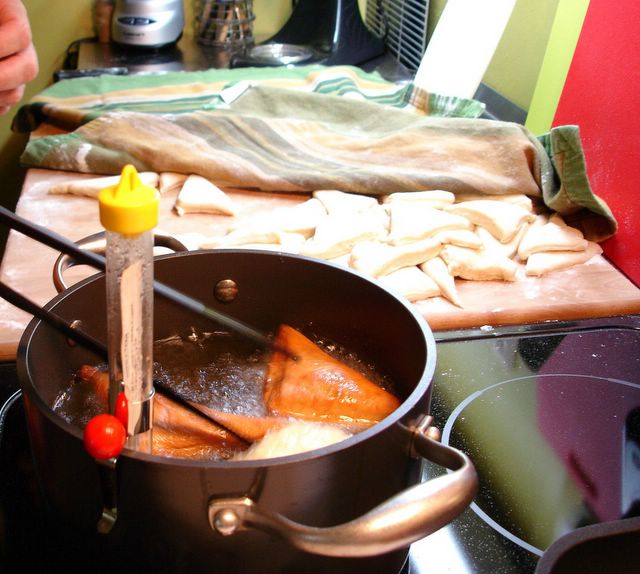
In matters of fat, Jimmy is clearly blessed. This morning he was a vision of apron-clad serenity, tongs in hand before the bubbling font. The burner of the stove, splattered with droplets of oil that glimmered under the light, glowed like a fallen halo. And most importantly, the dough began to puff divinely.
The first batch, as one might expect, was Rebecca’s,
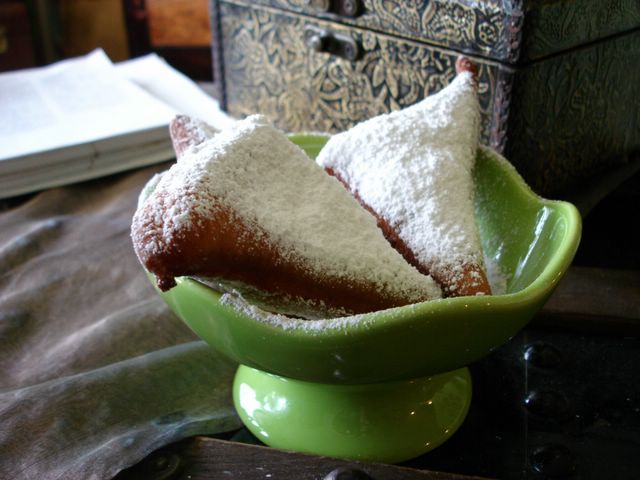
which allowed me the opportunity to watch and learn proper beignet-eating technique. And as luck would have it, not only is Rebecca a remarkably talented Pilates instructor, but she’s also gifted in the art of beignet consumption. Proper beignets are dusted with a thick blanket of powdered sugar, and, as she explained, in order to avoid the dreaded “white beard of shame” one must lean forward at a hard forty-five-degree angle while eating, preferably with a bowl under the chin. Understandably confident in her beard-avoidance skills, Rebecca wasted no time in letting loose with her usual cry: “Jimmy, there’s not enough sugar! There’s a naked corner here! Jimmy! More sugar!”
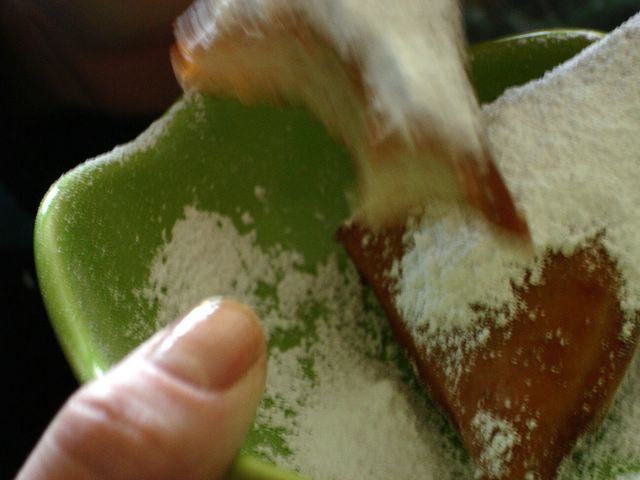
I adore this woman—even though she, when my bowlful of beignets was ready, made me laugh in mid-bite and thus forced a white sprinkling of shame down my pant leg.
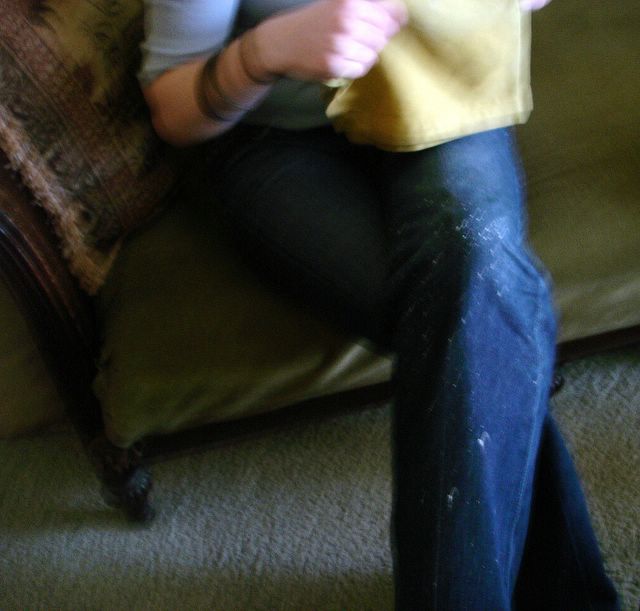
But then again, when you’re dealing with something as heavenly as Jimmy’s beignets,
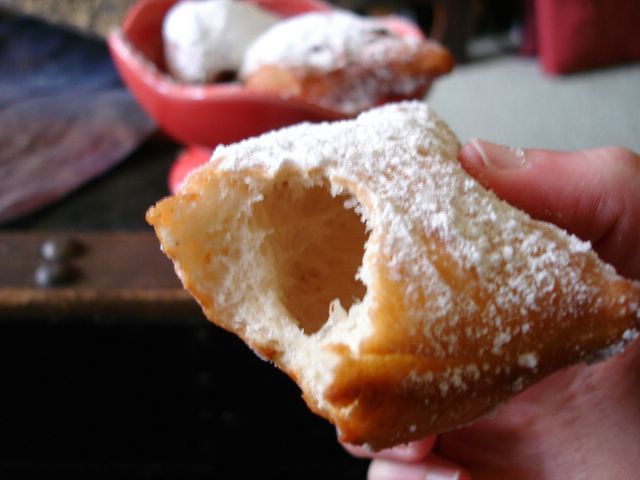
the concept of shame is pretty unfathomable. Some say that cleanliness is next to godliness, but I’ll take a hol(e)y beignet and sugar-coated legs instead. Sixteen exclamation points indeed. I hear that Jimmy is next in line for the papacy.
Seattle-Is-the-New-New-Orleans Beignets
Adapted from Chuck Taggart’s The Gumbo Pages
As long as you’re not afraid of a lot of hot oil, these aren’t terribly difficult to make at home. As Chuck says, “The yeast dough must be prepared in advance and refrigerated overnight. . . .For home preparation, the dough works better in the large quantity given here, enough for about [4] dozen beignets. Don’t worry, though…the dough keeps well under refrigeration for about a week. Just cut off some dough when you want to make beignets—roll it out, cut it up, and fry for about 3 minutes per batch. . . .Or just invite enough people over to eat all [4] dozen.”
1 package active dry yeast
1 ½ cups warm water (100-115 degrees Fahrenheit)
½ cup sugar
1 tsp salt
2 large eggs
1 cup evaporated milk
7 cups unbleached all-purpose flour
1 tsp ground nutmeg
¼ cup vegetable shortening (non-hydrogenated, if possible)
Vegetable oil, for frying (Jimmy chose Crisco brand oil)
Tons of powdered sugar, for dusting
Put the warm water into a large bowl (Jimmy did this and all subsequent mixing steps in the bowl of his KitchenAid stand mixer, fitted with the dough hook), and sprinkle in the yeast and a couple teaspoonfuls of the sugar. Stir until dissolved; then let rest for 10 minutes or so. Add the rest of the sugar, the salt, the eggs, and the evaporated milk. Gradually stir (or mix) in 4 cups of flour and the nutmeg, and beat with a wooden spoon (or dough hook) until smooth and thoroughly blended. Beat in the shortening, and then add the remaining flour, about 1/3 cup at a time, beating until it becomes too stiff to stir, and then working the rest in with your hands. Transfer the dough to an oiled bowl, cover the bowl with plastic wrap, and refrigerate overnight.
Roll the dough out onto a floured board to a thickness of 1/3 inch. Then, using a sharp knife, cut the dough into triangles measuring roughly 2 x 2 x 3 inches.
Pour the oil to a depth of roughly 4 inches in a large, deep saucepan or Dutch oven. Heat the oil to 360 degrees Fahrenheit, and fry the beignets 3 at a time until they are puffed and golden on both sides, about 2-3 minutes per batch. Turn them over in the oil with tongs once or twice to get them evenly brown, since they rise to the surface of the oil as soon as they begin to puff. From batch to batch, try to make sure to try to keep the oil as close to 360 degrees as possible; if necessary, allow a few minutes between batches for the oil to reheat to the proper temperature. Drain each batch for a minute or two on a platter lined with several layers of paper towels, and then dust heavily with powdered sugar. Serve three beignets per person—at least for the first round.

